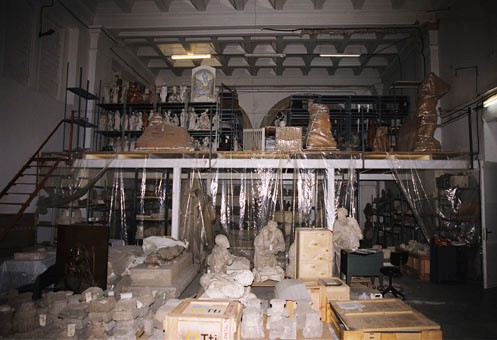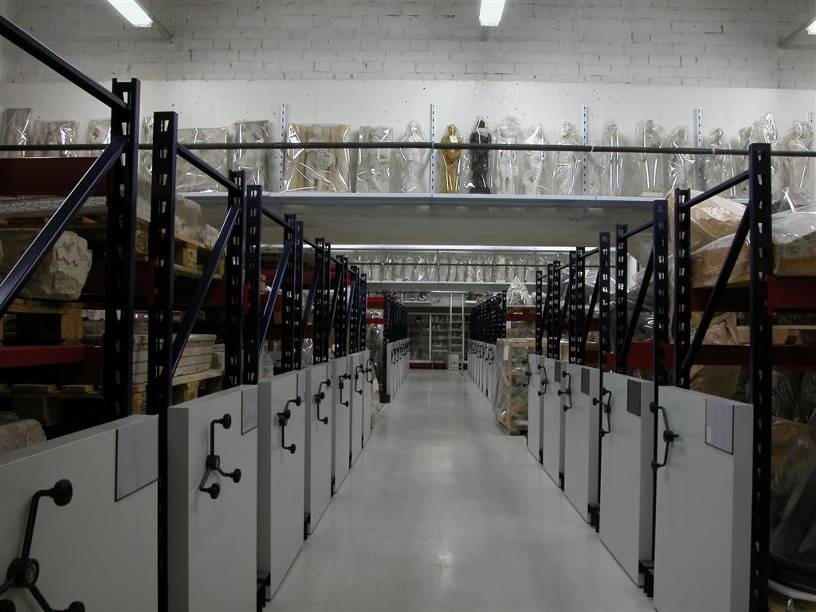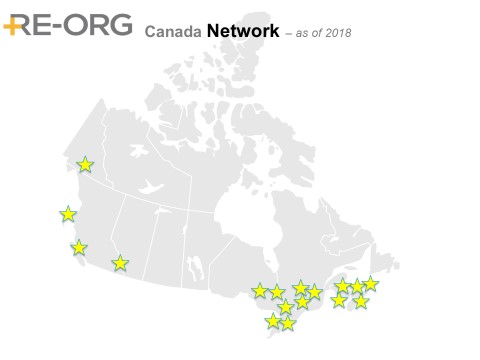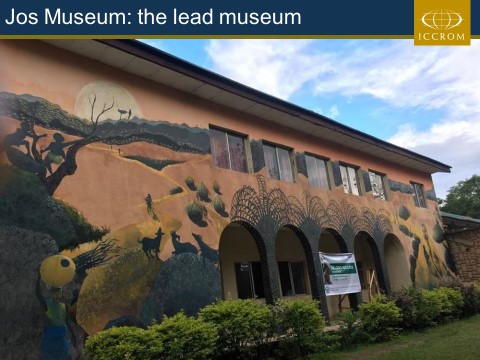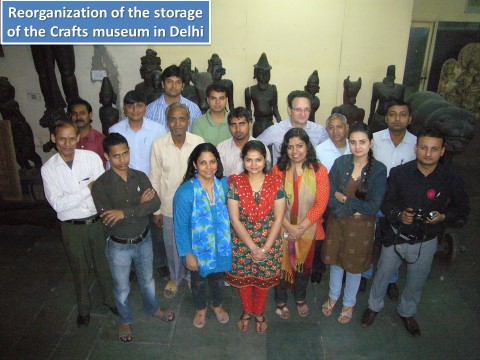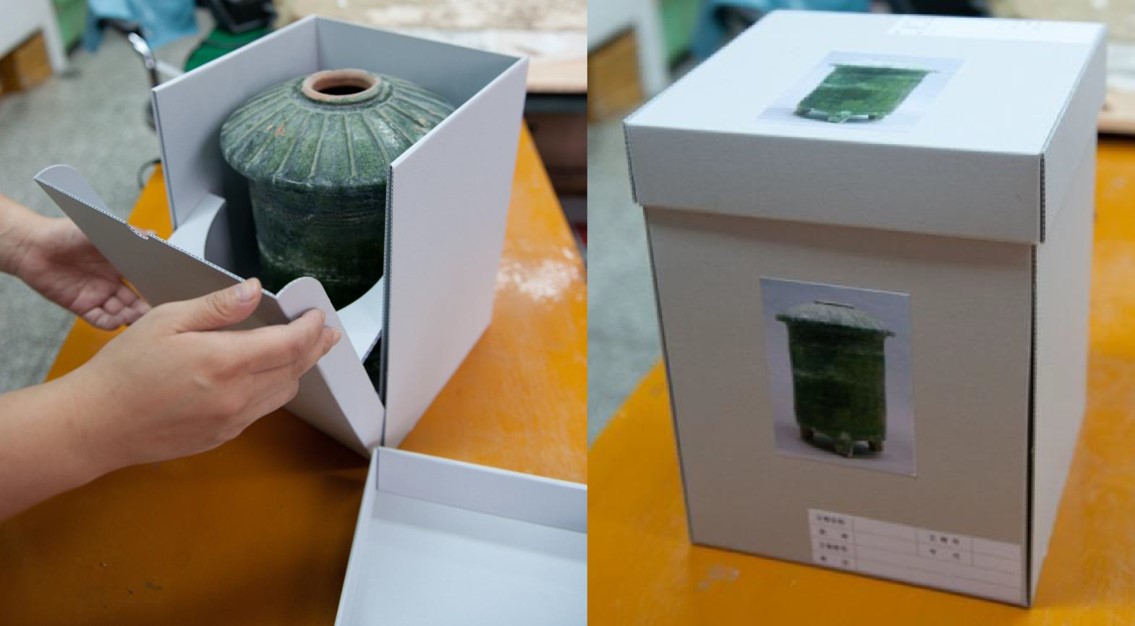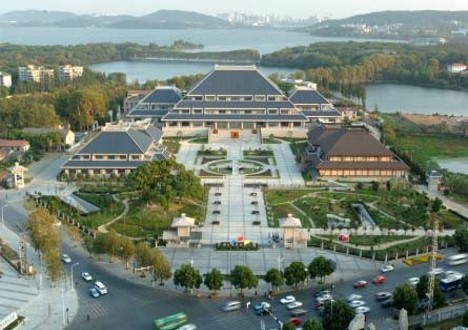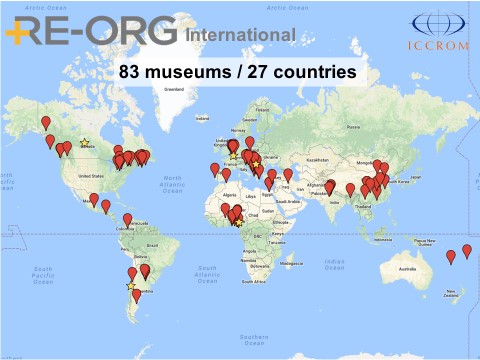Benoit de Tapol
Canada, Belgium, India, Nigeria, Chile … these countries already have a national strategy for implementing the Re-Org programme in museums, a method for reorganizing storage spaces, improving storage and the system of documenting collections, created by ICCROM (International Centre for the Study of the Preservation and Restoration of Cultural Property) – UNESCO.
The Re-Org tool makes it possible to provide a quick diagnosis of the conditions in which the material in storage is conserved, based on an inspection taking everything into account (building, management and protocols, staff, collections, facilities…). It offers:
- Guidance for drafting a plan of action
- Pointers to learning more about the collections and their needs
- Calculation tables for optimizing storage space
- Help with establishing a budget and a work schedule.
ICCROM is establishing relationships for collaboration with national museums and conservation institutes in different countries to develop initiatives with this programme.
Canada, the pioneer in adopting Re-Org
The international survey (pdf, 55Kb) carried out in 2011 by ICCROM-UNESCO to find out the greatest risks facing collections in every country in the world obtained shocking results in the 86 Canadian museums surveyed. Some significant indicators:
53% of the museums had storerooms that were crammed full
38% of the museums received no management support
21% of the museums had not clearly defined the role of the person in charge of the storerooms
22% of the museums did not have a locating system.
In 2012 and 2013, 53% of all requests for expert assistance from Canadian museums received by the CCI (Canadian Conservation Institute) were related to the storerooms. In Canada, the distances between museums are very great, and so the cost of on-site expertise is in fact high. Canadian museums’ working budgets are very unequal; 16% of them are very small institutions and their budget is less than $100,000. Almost half of the museums, 46%, have a budget of between $100,000 and $500,000. The most important ones, 3%, have a budget greater than $15,000,000 (Canadian Museums Association 2016).
In order to be able to provide the requested advice, it was necessary to organize a distance tutorial or create a larger pool of qualified officers (coaches), relying on the most experienced professionals in the largest museums in the geographical area in question. It was necessary to use an easy working tool, well known and shared, which had to respond to the problems identified. Re-Org had all of this. The next stage consisted of looking for sponsors.
The Re-Org programme has been implemented in Canada for the last five years, at a rate of one workshop a year per province. The aim was twofold: to disseminate and practise the tool in real conditions in a museum that met the requirements, and to select coaches who would act as disseminators of the experience obtained.
The programme began in Ontario, with 10 museum professionals from five different institutions in the province: Lambton Heritage Museum, Timmins Museum, Collingwood Museum, West Parry Sound District Museum, and Norfolk Arts Centre at Lynnwood National Historic Site. The programme continued in 2015, moving towards the Atlantic coast with the training of 10 more professionals in the museums. In 2016 it was in Quebec, with six officers from three museums, and in 2017 on the West Coast with nine more museum officers.
In 2018, before it moved into the last area, the CCI, coordinated by Simon Lambert, had 17 museums associated with the project, of which four had played host to the practical reorganization workshop, 43 people had been trained and three “super coaches” had been identified.
The CCI’s aim was to successfully create operational teams, associating a properly trained coach with a preventive officer, a member of staff of a major museum that had used the Re-Org tool. In this way the presence of a proximity pairing was reinforced, capable of monitoring the supervision and reorganization of storage areas in the five geographical areas established.
Exportation of the Re-Org model
The model has been exported to Belgium, where Marjolijn Debulpaep, head of the preventive conservation department of the IRPA (Royal Institute for Cultural Heritage) coordinated and developed a series of Re-Org workshops from 2015 to 2018, with the intention of training coaches, after repeated experiences with the methodology.
Staff from 12 Nigerian museums benefited from the Re-Org tutorial given by the ICCROM in November and December 2017.
In India, the coordination of the Re-Org programme, shared between ICCROM and the Indira Gandhi National Centre for the Arts, was implemented in 2012, in collaboration with the CCI. In 2013 the storage spaces in the Crafts Museum in Delhi were reorganized, with the coaching of ICCROM, IGNCA, and the Museu Nacional d’Art de Calalunya. Other museums currently complete the network.
The museums network of Southeast Europe, with the support of ICOM, has adopted the Re-Org programme. In Belgrade the first training course for trainers was held in 2014 with the participation of the Museu Nacional d’Art de Catalunya. An agreement between the Museu Nacional and ICCROM has enabled an officer from the museum, the author of this article, to collaborate with this programme to develop working documents.
The museums networks in China, Milan and Catalonia get ready to host Re-Org
China, growing at a rate of 100 museums a year, will be the new addition to these countries that have decided to introduce a national strategy based on the Re-Org methodology and working tool, making it possible to give support to the museums that need it.
In China, the first Re-Org workshop was organized in 2015 in the city of Chengdu with 10 participants. There are an estimated 4,800 museums in China, whose collections contain more than 64 million works, and 35,000 archaeological pieces are discovered every year, according to the latest figures.
Development of the Cultural Heritage. Among other things, this plan provides for the building of centralized standard storerooms for the areas where cultural assets are scattered or are difficult to safeguard. It provides museum storerooms with furniture and equips them with a centralized atmospheric control system. It has enacted 38 technical laws related to the conservation of collections and has planned to carry out more than 300 training courses to prepare more than 18,000 professionals. The possibility is being studied of introducing Re-Org in this five-year plan.
By 2018, officers from 83 museums in 27 different countries had received training in the Re-Org tool; however, there were no more than a dozen potential coaches, and ICCROM could not cope with the requests from the museums in the more than 130 member countries.
Networks of museums in Milan and the museums network in Catalonia are on the waiting list to organize a Re-Org operation.
The need to increase trainer training
ICCROM had to go beyond one-off training-action operations for singular museums, and it had to encourage national strategies ensuring greater impact with the participation of the most advanced institutions in the country. For this reason it was necessary to increase the number of coaches and consider specific training.
Collections Unit, with the support of Gaël de Guichen, assistant director of ICCROM, summoned the preventive conservation officers who had taken part in the Re-Org workshops to Rome (representatives from China, India, Nigeria, Chile, Belgium, Canada, Switzerland, Italy, Serbia and Spain).
These officers were set the task of preparing training courses for the future trainers who in the coming years will have to monitor the museums in the national and/or regional networks that wish to use Re-Org. They also had to identify other aspects that would consolidate the results of the programme: drafting guidelines for launching a national strategy, developing additional resources to encourage implementation of the programme that is as autonomous as possible, and outlining a communications strategy to enable them to raise awareness among museums’ associations and the people in charge of institutions.

